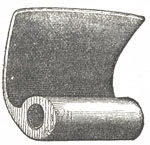The Festology of Aengus
After the invocation follows a preface, the second part of this remarkable poem. In this there is a glowing account of the tortures and sufferings of the early Christian martyrs; it tells "how the names of the persecutors are forgotten, while the names of their victims are remembered with honour, veneration, and affection; how Pilate's wife is forgotten, while the Blessed Virgin Mary is remembered and honoured from the uttermost bounds of the earth to its centre." The martyrology proper, or festology, comes next, and consists of 365 quatrains, or a stanza for each day in the year.
It commences with the feast of the Circumcision:—
"At the head of the congregated saints
Let the King take the front place;
Unto the noble dispensation did submit
Christ—on the kalends of January."
St. Patrick is commemorated thus, on the 17th of March:—
"The blaze of a splendid sun,
The apostle of stainless Erinn,
Patrick, with his countless thousands,
May he shelter our wretchedness."
On the 13th of April, Bishop Tussach, one of the favourite companions of the great saint, is also mentioned as—
"The kingly bishop Tussach,
Who administered, on his arrival,
The Body of Christ, the truly powerful King,
And the Communion to Patrick."
It will be remembered it was from this saint that the great apostle received the holy viaticum. In the third division of his great work, Aengus explains its use, and directs the people how to read it.
It will be manifest from these poems that the religious principles of the Culdees and of the Irish ecclesiastics generally, were those of the Universal Church at this period. We find the rights of the Church respected and advocated; the monarchs submitting to the decision of the clergy; invocation of the saints; the practice of administering the holy viaticum; and the commemoration of the saints on the days devoted to their honour.
Usher observes, that the saints of this period might be grouped into a fourth order.[9] Bede says: "That many of the Scots [Irish] came daily into Britain, and with great devotion preached the word and administered baptism......The English, great and small, were by their Scottish [Irish] masters instructed in the rules and observances of regular discipline."[1] Eric of Auxerre writes thus to Charles the Bald: "What shall I say of Ireland, which, despising the dangers of the deep, is migrating with her whole train of philosophers to our coast? Rency, after describing the poetry and literature of ancient Erinn as perhaps the most cultivated of all Western Europe, adds, that Ireland " counted a host of saints and learned men, venerated in England [2] and Gaul; for no country had furnished more Christian missionaries." It is said that three thousand students, collected from all parts of Europe, attended the schools of Armagh; and, indeed, the regulations which were made for preserving scholastic discipline, are almost sufficient evidence on this subject.
The discussions of the Irish and English ecclesiastics on the time of keeping of Easter, with their subsequent decision, and all details concerning domestic regulations as to succession to office and church lands, are more properly matters for elucidation in a Church History, for which we reserve their consideration.

Ancient Adze from the collection of the Royal Irish Academy
Notes
[9] Order.—This refers to the vision in which St. Patrick is said to have seen three orders of saints, who should succeed each other in Ireland.
[1] Discipline.—Bede, lib. iii. cap. 3. We have used Bohn's translation, as above all suspicion.
[2] England.—Camden says: "At that age the Anglo-Saxons repaired on all sides to Ireland as to a general mart of learning, whence we read, in our writers, of holy men, that they went to study in Ireland"—Amandatus est ad disciplinam in Hibernian.
